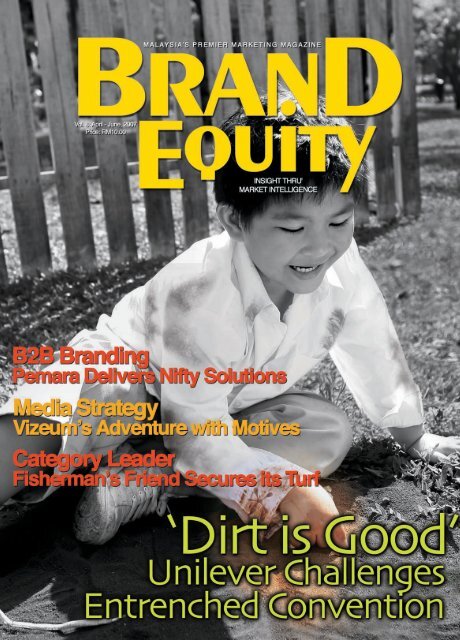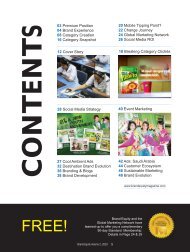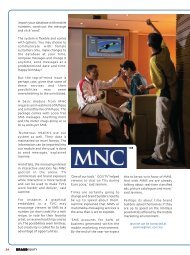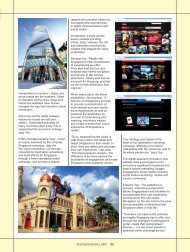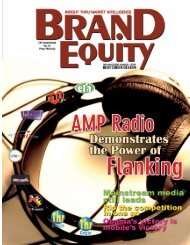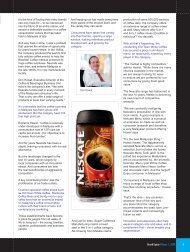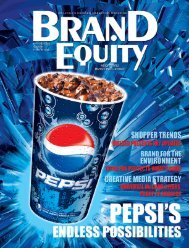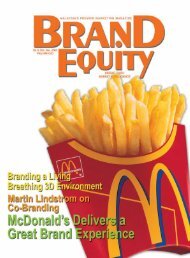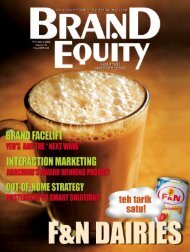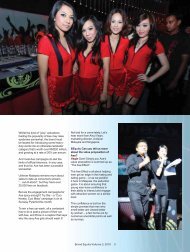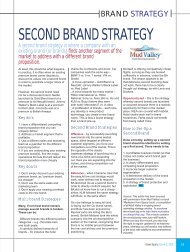market - Brand Equity Magazine
market - Brand Equity Magazine
market - Brand Equity Magazine
Create successful ePaper yourself
Turn your PDF publications into a flip-book with our unique Google optimized e-Paper software.
EDITOR’S NOTE<br />
of a brand proposition.<br />
BRANDEQUITY<br />
It takes an<br />
assortment<br />
of elements<br />
to drive the<br />
success of<br />
any brand or<br />
guarantee the<br />
acceptance<br />
To operate successfully under prevailing<br />
conditions, the assortment must include<br />
innovation, the pursuit of differentiation, a<br />
willingness to embrace new technologies and<br />
an attitude that is primed to snub convention.<br />
It’s the last element in the list that triggers<br />
curiosity. A head-on assault on established<br />
convention and other social values may invite<br />
serious repercussions.<br />
But Unilever’s experience continues to prove<br />
otherwise. The lead story details as much how<br />
a collision with convention, when fronted by<br />
strategic insights and clever execution, can<br />
deliver great results.<br />
This issue also features a company that<br />
is encouraging brand builders to push the<br />
boundaries of communications even further.<br />
Pemara Labels offers nifty solutions that<br />
facilitate direct brand-consumer dialogue.<br />
And MNC Wireless continues to harness the<br />
power of mobile technology to better manage<br />
the brand-customer interface.<br />
Everything aside, the assortment needs the<br />
inclusion of one more element – the propensity<br />
for taking calculated risks.<br />
Food for thought – how risk-sensitive is your<br />
brand building team?<br />
Cover Story 08<br />
<strong>Brand</strong>Law 16<br />
B2B <strong>Brand</strong>ing 04<br />
<strong>Brand</strong> Evolution 00<br />
<strong>Brand</strong> Communications<br />
42<br />
CONTENTS<br />
Published by:<br />
perception<br />
media<br />
Perception Media Sdn Bhd 3-3, Jalan 11/48A, Sentul Raya Boulevard, 51000 Kuala Lumpur Tel : 03 4043 0500 Fax : 03 4043 7648<br />
Publisher : James Selva Executive Publisher : RT Selvi Publishing Director : RS Kumar<br />
Group Editor : CGN Raghunath (email:brandman@tm.net.my) Staff Writer : Chris Krishna<br />
Contributors : Cseng Lim, George Aveling, Jane Prior, Jeff Zweig, R. Venkateswaran Marketing Manager : A Veerasingam, Anenda Sharma,<br />
Senior Graphic Designer : N Hemalatha Graphic Designer : G Kayathri, V A Kanmani<br />
Dtp Artist : S Savithri Production Coodinator : R Sangeetha, IT Executive : Vani Sri Administration : Kavitha<br />
Printed By : BHS Book Printing Sdn Bhd Lot 17-22 & Lot 17-23, Jalan Satu, Bersatu Industrial Park,Cheras Jaya, 43200 Cheras, Selangor<br />
PP11255/4/2007<br />
A Member Of<br />
B B BRANDING<br />
Labels that Deliver a Great Experience<br />
COvER STORy<br />
‘Dirt is Good’<br />
CATEGORy BRAND LEADER<br />
A Heritage that Soothes<br />
BRANDLAW<br />
Apple’s iPhone Conundrum<br />
NIELSEN MEDIA UPDATE<br />
Ad spending Exceeded Expectations in 2006<br />
MEDIA STRATEGy<br />
Matching Motives, Moments & Media<br />
MOBILE MARkETING<br />
Cost Effective Communications with Go!SMS<br />
WEB MARkETING<br />
Ways to Use RSS for Your <strong>Brand</strong>, Part 2<br />
BRAND AUDIT<br />
Market Research, <strong>Brand</strong> Audit<br />
and <strong>Brand</strong> Valuation - The Differences<br />
PUBLIC RELATIONS<br />
‘This Old Relationship Tangle…’<br />
BRAND DIRECTION<br />
Creating & Delivering the Best<br />
INTERACTION MARkETING<br />
An Innovation Web Campaign for Brylcreem<br />
BRAND COMMUNICATIONS<br />
BBDO Malaysia Conceives Great Ideas for KFC<br />
BRANDED CUSTOMER SERvICE<br />
Creating the On-<strong>Brand</strong> Experience<br />
04<br />
08<br />
13<br />
16<br />
19<br />
24<br />
28<br />
32<br />
34<br />
36<br />
38<br />
40<br />
42<br />
46
<strong>Brand</strong> <strong>Equity</strong> B2B BRANDING<br />
By Raghunath<br />
BRANDEQUITY<br />
Arthur Lai & Ngooi Pei Ling
Allan Lo<br />
Let’s say you’d like to intensify<br />
consumer-brand affinity with a keen<br />
eye on cost efficiency.<br />
So ideas and related problems pop<br />
up in the mind. How about a contest<br />
(forms are chucked in the car’s<br />
backseat, or out of sight at the retail<br />
end, some strewn around the garbage<br />
bin perhaps, reservations about<br />
absolute support of retailers).<br />
Provide additional information<br />
about the product (leaflet in the<br />
backseat again, the garbage<br />
bin, or delivered to the wrong<br />
audience); festive season is<br />
around the corner, and you’d<br />
like to tickle consumers with<br />
new recipes. The information<br />
consumes four letter-size<br />
pages (logistical issues,<br />
missing at the retail end,<br />
lost & found at the garbage<br />
dump…).<br />
A decision impasse<br />
looms. Then a team from<br />
Pemara Labels shoves a 36-page<br />
booklet replete with recipes into your<br />
hands and says they can affix it on the<br />
bottle!<br />
They insist its going to look great,<br />
is logistics friendly, very secure, and<br />
cost-effective. Wastage is minimal,<br />
and the recipes can hang on the<br />
bottle in the chiller as well.<br />
And sure you can dump the four<br />
letter-size pages. Better yet, your<br />
company has the opportunity to<br />
communicate directly with consumers<br />
in an exciting way.<br />
And what about consumer-brand<br />
affinity? ‘That will be delivered’, they<br />
insist. The point of difference? It’s<br />
now a teeny-weeny but eye-catching 4<br />
X 4 cm booklet. Tear the security seal,<br />
and out pops the smartly folded 36<br />
pages.<br />
Tracing its roots back to Australia,<br />
the innovative Pemara Labels<br />
is an international<br />
supplier<br />
of high<br />
quality labels as well<br />
as a wide array of promotional<br />
solutions.<br />
In Malaysia, its customers include<br />
Unilever, Johnson & Johnson, Sara<br />
Lee, GlaxoSmithKline and among<br />
others, Quaker Products. And<br />
customer relationships are regionally<br />
aligned.<br />
About delivering value to<br />
customers, Arthur Lai, the company’s<br />
Group GM, Asia explains, ‘Our point of<br />
differentiation is the ‘Pemara <strong>Brand</strong><br />
Experience’. Customers must see<br />
and feel the quality that we deliver<br />
consistently with smart processes and<br />
superior technology through our brand<br />
experience.’<br />
Back to the 36-page recipe booklet.<br />
Dubbed Fix-a-Form, this star product<br />
from Pemara Labels is a multi-page<br />
leaflet-label system that can be<br />
custom-made to support a variety of<br />
brand communications activities.<br />
‘The patented Fix-A-Form<br />
is versatile and can be used for<br />
contests, redemptions, discount<br />
vouchers, recipes and delivering<br />
detailed information about<br />
products. It is a hit among brand<br />
owners in Malaysia,’ says Ngooi Pei<br />
Ling, GM, Pemara Malaysia.<br />
Pemara’s product repertoire<br />
includes decorative labels with hot<br />
stamp, holograms, Trust Seals®,<br />
postage stamps, rub-n-sniff labels as<br />
well as Fix-a-Form.<br />
Much of Pemara’s initiatives<br />
address the concerns of brand owners.<br />
Explains Pei Ling, ‘Contest entry forms<br />
can be affixed on the package. The<br />
consumer does not have to waste time<br />
heading for the redemption counter.<br />
More importantly, the form remains<br />
accessible anytime so long as the<br />
consumer keeps the product. And they<br />
have more time to decide whether to<br />
participate.’<br />
‘The materials that we use are<br />
versatile as well. The labels do not<br />
disintegrate or peel off surfaces that<br />
condense. This would be a concern<br />
with soft-drink cans,’ she adds.<br />
The past few years bore witness to<br />
the rising concern for security; a trend<br />
BRANDEQUITY
not missed by Pemara’s radar. ‘Most<br />
scratch & win labels out there do not<br />
match the quality we deliver. With<br />
inferior quality, prizes can be visible<br />
under strong light. The hot stamping<br />
process we use for such labels is very<br />
secure,’ says Allan Lo, Pemara’s Sales<br />
Manager.<br />
Categories such as cigarettes,<br />
alcohol beverages, agrochemicals,<br />
pharmaceuticals tend to fall prey<br />
to counterfeiting activities. Allan<br />
recommends the use of Trust Seals® to<br />
preserve the integrity of packages as<br />
well as promo activities.<br />
‘The product is licensed from<br />
a German company and is used on<br />
currency notes as well. It can be<br />
applied on cash or gift vouchers<br />
and incorporated into Fix-a-Form<br />
labels as well. More importantly, it is<br />
difficult to imitate,’ he says.<br />
Arthur adds that customer<br />
BRANDEQUITY<br />
engagement does not stop with a sale.<br />
‘We also organize seminars to inform<br />
customers about the innovative ways<br />
they can use our products to enhance<br />
their customer brand experience<br />
as well. Some occasions it is done<br />
in collaboration with the Chartered<br />
Institute of Marketing, Malaysia’ says<br />
Arthur who is the Honorary Secretary<br />
in the council.<br />
He also says that Pemara is<br />
committed to collaborating with<br />
its strategic partners for delivering<br />
solutions that set new standards<br />
for performance, reliability and<br />
sustainability.<br />
Partners include the industry’s<br />
respected names in pre-press and<br />
print technology. The list includes<br />
Tycine Colour Separation, Xsys Print<br />
Solutions Malaysia, Leonhard Kurz<br />
from Germany as well as Multifoil Sdn.<br />
Bhd.<br />
Arthur says that their brand<br />
experience is facilitated by state-ofthe-art<br />
technology. ‘Technology has<br />
helped implement the ‘One Pemara’<br />
concept. Jobs that are repeated or<br />
implemented in different countries<br />
deliver identical quality while<br />
managed from a central location.<br />
We can deliver quality proofs to<br />
customers while our machines are in<br />
operation as well,’ notes Arthur.<br />
Product or process, quality plays<br />
a key role in delivering the Pemara<br />
<strong>Brand</strong> Experience.<br />
And as you admire the label or<br />
affixed note on your favorite shampoo<br />
brand, or wine, or liquid car polish,<br />
chances are that the intense signal it<br />
emits may bear the signature of the<br />
Pemara brand experience.<br />
Please direct your enquiries<br />
to info@pemara.com.my
<strong>Brand</strong> <strong>Equity</strong> COVER STORY<br />
By Raghunath<br />
BRANDEQUITY
So what’s wrong with dirt, challenges<br />
Breeze, a stellar brand delivered from<br />
the belly of global consumer goods<br />
juggernaut Unilever.<br />
Intent on changing the rules of the<br />
game, the company has been launching<br />
compelling offensives against<br />
deep-seated mores as well as social<br />
values that are not in tune with the<br />
times.<br />
Lately, Unilever’s in-your-face<br />
campaigns have been daring consumers<br />
to recast their beliefs; and in the<br />
process, inciting doubts about out-ofform<br />
values.<br />
So they are urging people to get<br />
out there and celebrate life with a<br />
dash of vitality, toss out inhibitions<br />
about their personas, challenge the<br />
pressures they have to deal with (such<br />
as how they look), and to get real<br />
about happenings in the slices that<br />
make up their lives.<br />
That explains the shift in the brand<br />
philosophy of Breeze.<br />
Sze Tian Poh<br />
Breeze is<br />
ProDirt<br />
Explains Sze Tian Poh, Unilever’s<br />
Chairman & MD for Malaysia &<br />
Singapore, ‘Play offers the opportunity<br />
to learn in every child’s growing<br />
years. Children need to play to<br />
develop their creativity, enhance their<br />
motoring skills and cultivate positive<br />
values such as teamwork and healthy<br />
competition. Therefore, we are urging<br />
Malaysian parents to encourage their<br />
children to play without the worry<br />
of dirt as Breeze will be at hand to<br />
remove stains effectively.’<br />
But it’s a direction that’s been<br />
realized with fitting moves as well.<br />
Breeze was the only detergent brand<br />
to share the football fever during the<br />
World Cup period. The promotional<br />
activity launched the Breeze Splat<br />
Balls, which carried the signature of<br />
international footballer, Ronaldhino.<br />
The company embarked on a<br />
charity drive to build safe playgrounds<br />
for orphanage homes as well. Another<br />
is on its way.<br />
But there is an affirmed obsession<br />
of sorts that drives the brand<br />
builders at Unilever. ‘We embrace a<br />
philosophy that persuades us to focus<br />
more on consumers rather then the<br />
competition, to be fanatical about<br />
consumer needs and deliver them<br />
when they need it,’ says Sze.<br />
The Mission<br />
‘We want people to feel good, look<br />
good and get more out of life itself,’<br />
he adds. ‘We want to focus on new<br />
consumer opportunities to grow our<br />
business. Our mission is to add vitality<br />
to life.’<br />
And vitality to consumers can showup<br />
in the form of clean hands, healthy<br />
smiles, clean homes, getting noticed,<br />
having more time for themselves and<br />
BRANDEQUITY
others, or even pampered skin.<br />
So Unilever’s new mantra seeks to<br />
spurn conventional brand <strong>market</strong>ing<br />
practices and propositions while<br />
maneuvering their brands into<br />
uncontested arenas.<br />
Sure it sounds very much like<br />
its business as usual. But it needs<br />
a trained eye and mind to spot<br />
opportunities, and risk venturing into<br />
any uncontested space, and with<br />
everyone watching.<br />
Where’s the<br />
Hair?<br />
Sample this – two years back Sunsilk<br />
fired a different broadside that raised<br />
many eyebrows. They were the first<br />
to advertise a shampoo brand with<br />
every strand of hair out of sight. That’s<br />
taking a risk; calculated or not remains<br />
a different matter.<br />
A killer insight that homed into the<br />
nuances of Muslim women donning the<br />
10 BRANDEQUITY<br />
headscarf led the way. Again, it’s a<br />
trained eye that was spot-on with the<br />
uncontested area.<br />
Be Life<br />
Confident<br />
At the moment Sunsilk is getting<br />
cuddly with teenagers experiencing<br />
predicaments while making decisions<br />
concerning many aspects of their<br />
lives. The brand insists that it<br />
understands that growing up is<br />
all about facing challenges and<br />
dilemmas.<br />
So in comes a 15-minute<br />
interactive entertainment program<br />
with a social cause that helps<br />
disseminate good moral values to<br />
young Malaysians. It’s a drama series<br />
that showcases how a character goes<br />
through her life filled with challenges<br />
and dilemmas as a teenager. The<br />
character resonates with Sunsilk’s<br />
personality – warm, friendly and<br />
vitality to<br />
consumers can<br />
show-up in the<br />
form of clean hands,<br />
healthy smiles,<br />
clean homes,<br />
getting noticed,<br />
having more time<br />
for themselves and<br />
others, or even<br />
pampered skin.<br />
approachable. And her life situation<br />
reflects the life of Malaysian<br />
teenagers.<br />
A supporting SMS campaign invites<br />
viewers to suggest what the character<br />
should do next, and prizes are given<br />
away for spotting the ‘moral of the<br />
story’ which reflects Sunsilk’s values.<br />
The upside? Sunsilk leads with over<br />
30% share of the <strong>market</strong>.<br />
Dove is ProAge<br />
A tale about an all-out assault on<br />
convention is worth telling. The<br />
contemporary consumer culture is<br />
replete with elements that are hellbent<br />
on gratifying the desire for great<br />
looks, while ‘great looks’ remain<br />
beyond reach to many hopefuls.<br />
It’s all out there – Botox, eyelid<br />
lift, liposuction, breast augmentation,<br />
chemical peel; and add the tendency<br />
for consumers to cave-in to messages<br />
from peers and role models.
Campaigns that exploit the power of association<br />
often feature models with archetypal looks that most<br />
women can only dream about!<br />
But Dove took the diametrical route; and<br />
challenged convention. The brand decided to get<br />
honest with in-your-face visuals and messages<br />
that told women that whatever their skin type, or<br />
body shape, or age, or color, or looks – the need to<br />
conform or otherwise is a matter of confidence, and<br />
choice.<br />
The ‘Campaign For Real Beauty’ as it was dubbed<br />
urged women to accept the fact that there is beauty<br />
in diversity, and in natural looks.<br />
It urged women to reexamine their values, and<br />
assured them that there is a certain beauty about<br />
them that they can revel in, and treasure. Much was<br />
done to elevate their self-esteem.<br />
The campaign persuaded women to speak-up,<br />
enter into a dialogue and eventually feel beautiful.<br />
The result? Dove’s assault has developed into one<br />
of the world’s most innovative, iconic and universally<br />
acclaimed campaigns of modern times. It became a<br />
PR triumph, set it well apart from rival brands and<br />
won acclaim from women worldwide.<br />
The Campaign For Real Beauty took off in Malaysia<br />
at the end of 2005. Shot in Bangkok, it raised new<br />
debates around traditional Asian stereotypes on beauty, in<br />
contrast to the Western executions of 2004. Single eyelids and<br />
short hair were added to the debate.<br />
‘This year the Campaign For Real Beauty will get into high<br />
gear in Malaysia,’ says Sze.<br />
HIRAMEKI, a State of<br />
Inspiration<br />
And what gives with Lipton, the world’s leading tea brand<br />
and global <strong>market</strong> leader in leaf and ready-to-drink tea? An<br />
initiative by Lipton is further communicating the goodness of<br />
tea to consumers.<br />
The ongoing HIRAMEKI campaign extols the virtues of<br />
another natural ingredient in tea that claims to further<br />
enhance its goodness to the human body.<br />
An alliance with Oxford University has established the<br />
presence of theanine in every cup of Lipton. Theanine is<br />
purported to give a relaxed but alert state of mind – thus the<br />
state of inspiration known as HIRAMEKI.<br />
Says Sze, ‘We expect two distinct groups of consumers<br />
to benefit from our findings; the thriving youth who want to<br />
perform well at school and at work, and the aging community<br />
who want to maximize and maintain cognitive abilities.’<br />
Moo!<br />
Persuading a child to down a glass of milk can be<br />
exasperating. And everyday that too. So manage that aversion<br />
for milk by hunting for a suitable substitute.<br />
BRANDEQUITY 11
Deliver the Calcium through a product as well as<br />
experience that children will clamor for. The challenge<br />
inspired the introduction of the ice-cream brand ‘Moo’<br />
in Indonesia. Sze says that the successful brand has<br />
made a promising presence in Malaysia.<br />
Best Practices Shared<br />
A flurry of ceaseless activities continues to elevate the<br />
competencies of Unilever’s brand builders.<br />
Explains Sze, ‘Our Intranet is well engineered to<br />
facilitate global sharing of information, knowledge<br />
and ideas. There are dockets for every brand and each<br />
carries information about best practices. A manager in<br />
Malaysia can contact a counterpart in any part of the<br />
world to inquire about best practices relevant to their<br />
brand.’<br />
Lessons Learnt<br />
There’s much to be inferred from Unilever’s quest for<br />
<strong>market</strong> ascension.<br />
Being obsessed about consumer nuances must be a<br />
springboard for every decision and campaign. <strong>Brand</strong><br />
imprints must have a heart, and celebrate people as<br />
well as life itself.<br />
The consumer-brand connection must be absolute,<br />
and forged with an essence that must be extended to<br />
all <strong>market</strong>s worldwide. And brand footprints must be<br />
extended to cover many parts of the world. Decisions<br />
are more global with some room for responding to local<br />
nuances.<br />
Besides, brands that continually opt for pertinent<br />
differentiation have a better shot at succeeding. The<br />
overall well-being of the consumer has to play a major<br />
role in determining the direction of the brand.<br />
And aping the competition will deliver, but only in<br />
the short term. Strategic moves must be accompanied<br />
by that propensity for risk-taking.<br />
More importantly, challenging convention can deliver<br />
great results.<br />
Moving Forward<br />
Well into his 19 th year with Unilever, Sze is the first<br />
local to assume the Chair. It has been over two years,<br />
and the man operates with all eyes on cash flow as well<br />
as the terminal value of Unilever’s brand repertoire.<br />
So what’s the team gunning for? ‘We want to bring<br />
some meaning to our brands and that will make our<br />
work meaningful. And at the same time grow the<br />
business as fast as we can to support the meaningful<br />
work we are doing,’ says Sze.<br />
And his candid message for aspiring brand builders?<br />
‘Strive to inject meaning into your brand building<br />
activity. You will then be willing to suffer for what you<br />
are doing. Otherwise, just don’t do it.’<br />
12 BRANDEQUITY<br />
Being obsessed<br />
about consumer<br />
nuances must be<br />
a springboard for<br />
every decision and<br />
campaign. <strong>Brand</strong><br />
imprints must<br />
have a heart, and<br />
celebrate people<br />
as well as life
<strong>Brand</strong> <strong>Equity</strong> CATEGORY BRAND LEADER<br />
By R. Venkateswaran<br />
BRANDEQUITY 13 13
Would you believe that a popular<br />
throat drop brand available at your<br />
friendly grocer had its origin outside<br />
of Asia just about 140 years ago?<br />
Better yet, the very same ‘miracle<br />
lozenge’ was conceived to give relief<br />
to fishermen who suffered from<br />
coughs, colds and other bronchial<br />
difficulties while battling the elements<br />
at sea.<br />
In the early days, Fisherman’s<br />
Friend offered one variant. It last<br />
recorded worldwide sales of over<br />
US$350 million through eight flavors<br />
made available in more than 130<br />
countries. In Malaysia, it claims<br />
leading position with 21% share in the<br />
throat drop category.<br />
Fisherman’s Friend is propositioned<br />
as a ‘daily use’<br />
brand. The<br />
product range<br />
is classified as a<br />
‘functional candy’<br />
that is throatfriendly.<br />
Among<br />
others, it is said<br />
to help clear<br />
throat irritations,<br />
alleviate coughs<br />
and colds, unblock<br />
nasal passages<br />
and relieves sore<br />
throats.<br />
‘The consistent<br />
flavor and the<br />
benefits it delivers continue to<br />
be a draw for a broad spectrum<br />
of customers in the urban as well<br />
as semi-urban areas,’ says Mohan<br />
Alagappar, General Manager of<br />
GBA Corporation, which distributes<br />
Fisherman’s Friend in Malaysia.<br />
‘The popularity of this product is<br />
14 BRANDEQUITY<br />
also reflected in the target customer<br />
profile – mostly male or female adults<br />
who want to clear their throat,<br />
and if they are smokers, mask<br />
any unpleasant odor. Presently,<br />
many want the benefit of fresh<br />
breath from drops that come<br />
without the usual calories<br />
found in typical sugar<br />
candies. Others simply<br />
suck the lozenges for<br />
inspiration,’ shares Mohan<br />
who also adds that many<br />
undergraduates splurge on their<br />
brand to stay alert.<br />
In addition, the rising concern<br />
for well-being has helped the brand<br />
with the introduction of sugar free<br />
variants. But product development<br />
initiatives have<br />
encouraged<br />
sensitivity<br />
to culture<br />
inspired<br />
flavors.<br />
Asian<br />
flavored<br />
SKU’s have been<br />
introduced as well.<br />
Key Asian distributors<br />
have inspired the<br />
development of two<br />
fusion flavors; apple<br />
& cinnamon and<br />
mandarin & ginger.<br />
And Fisherman’s Friend is well<br />
distributed nationwide through a<br />
variety of retail establishments; from<br />
hypermarts to traditional stores.<br />
Impulse purchases account for a<br />
sizeable chunk of sales, especially<br />
through pharmacy chains, petrol<br />
stations and convenience stores.<br />
It last recorded<br />
worldwide sales<br />
of over US$350<br />
million through<br />
eight flavors made<br />
available in more<br />
than 130 countries.<br />
In Malaysia, it<br />
claims leading<br />
position with 21%<br />
share in the throat<br />
drop category.
How about consumption? ‘Most of<br />
our customers finish a pack in 3 to<br />
4 days,’ says Jamie Loh, Marketing<br />
Manager of GBA. She added that the<br />
unique paper gloss finish package<br />
helps retain freshness for the<br />
duration once it has been opened.<br />
The popular 25gm pack available<br />
in all flavors retails for RM3.50.<br />
Flanking that on the shelves is a<br />
compact 11gm pack, which retails for<br />
RM2.00.<br />
In order to retain its premium<br />
brand positioning in the <strong>market</strong><br />
vis-à-vis other similar brands,<br />
GBA executes timely and unique<br />
promotional activities, supported by<br />
an annual A&P spend of more than<br />
RM3 million.<br />
Key ground initiatives to position<br />
the brand include free sampling<br />
programs at high traffic outlets,<br />
concerts, pubs, sporting events and<br />
Mostly male or<br />
female adults who<br />
want to clear their<br />
throat, and if they<br />
are smokers, mask<br />
any unpleasant<br />
odour. Presently,<br />
many want the<br />
benefit of fresh<br />
breath from drops<br />
that come without<br />
the usual calories<br />
found in typical<br />
sugar candies.<br />
exhibitions. Supporting wholesaler<br />
programs do their bit as well.<br />
The activities are supplemented<br />
by the annual ‘National Sales Blitz’<br />
in which the entire sales team walk<br />
the street, swoop down to over 1000<br />
outlets, clean up merchandise at<br />
existing outlets and use the occasion<br />
to rope in new distribution points.<br />
In an increasingly competitive<br />
<strong>market</strong>, Jamie believes Fisherman’s<br />
Friend’s USP of consistent taste, no<br />
irritating cough, fresh breath and<br />
the fact that it is sugar free topped<br />
with a nominal cost places it at more<br />
than arm’s length from its nearest<br />
competitor.<br />
And by demonstrating concern for<br />
Asian palettes, ongoing R&D as well<br />
as <strong>market</strong> intelligence has helped<br />
Fisherman’s Friend to stay ahead<br />
and sustain leadership position in its<br />
category.<br />
BRANDEQUITY 15 15
<strong>Brand</strong> <strong>Equity</strong> BRANDLAW<br />
16 BRANDEQUITY<br />
By Benjamin J. Thompson<br />
& V. Mugunthan<br />
Welcome back to the <strong>Brand</strong>Law<br />
Column of <strong>Brand</strong> <strong>Equity</strong>!<br />
In the new series, we will be discussing<br />
cases of <strong>Brand</strong>s running into problems<br />
with the Law, with the hope that we might<br />
learn some important lessons through the<br />
experiences of others.
The merits and demerits of<br />
registering one’s trademark can<br />
be discerned in the Apple/Cisco<br />
controversy.<br />
Most techies will undoubtedly be<br />
aware of the brouhaha surrounding<br />
the launch of the newest member of<br />
Apple Computer’s product line, the<br />
iPhone mobile phone.<br />
The launch of the supposedly<br />
epoch-making product has been<br />
mired in controversy due to the rival<br />
claims of ownership between Cisco<br />
systems and Apple over the name<br />
iPhone.<br />
The following sequence of events,<br />
as gleaned from various articles and<br />
discussions on the Internet, may help<br />
shed some light on the lessons to be<br />
derived from the much publicized<br />
dispute.<br />
In March of 1996, Infogear<br />
Technology Corporation, a technology<br />
and services company focusing<br />
on Internet appliances filed an<br />
application for the US trademark<br />
‘iPhone’, obtaining the registration<br />
in 1999.<br />
The products to which the<br />
trademarks were applied were<br />
computer hardware and software<br />
for providing integrated telephone<br />
communication with computerized<br />
global information networks. This<br />
highfalutin description basically<br />
means a mobile phone which is<br />
capable of surfing the Internet.<br />
In 1998, Infogear released just<br />
such a product calling it the iPhone.<br />
Furthermore, in 2000, Infogear<br />
successfully prosecuted a trademark<br />
infringement claim against the<br />
owners of the iphones.com domain<br />
name.<br />
In June 2000, Cisco Systems<br />
acquired Infogear and its assets,<br />
including the iPhone trademark, and<br />
subsequently launched a range of<br />
Voice over IP (VoIP) sets under the<br />
name iPhone.<br />
Apple launched the iphone<br />
multimedia/Internet-enabled phone<br />
on the 9 th of January, 2007 with an<br />
eye towards emulating the success of<br />
i-Pod portable media players.<br />
Apart from the features that<br />
accompany most models of mobile<br />
phones, Apple’s iPhone has a touch<br />
screen incorporating a virtual<br />
keyboard which requires nothing<br />
more to operate it than bare skin i.e.<br />
one’s fingers. It also has a built in Wi-<br />
Fi enabling it to access the Internet<br />
through its own Safari browser.<br />
Therein lay the seeds of discord<br />
with Cisco. Cisco has contended that<br />
they had been negotiating with Apple<br />
to license their iPhone trademark<br />
and expected Apple to agree to<br />
the final document that Cisco had<br />
submitted on the night of the 8 th of<br />
January.<br />
Apple’s launch was made on<br />
9 th January 2007. On the 10 th of<br />
January, Cisco announced that<br />
it has commenced infringement<br />
Benjamin J. Thompson<br />
proceedings against Apple for using<br />
the iPhone name. Cisco also sought<br />
an injunction in the US federal court<br />
to prevent Apple from using the<br />
iPhone name.<br />
Just as things were beginning<br />
to get exciting, both parties to<br />
the dispute announced that they<br />
had agreed to temporarily suspend<br />
litigation pursuant to talks on<br />
settling the dispute. On the 20 th of<br />
February both parties announced<br />
that they had reached a settlement.<br />
Both parties will be allowed to use<br />
the iPhone name in exchange for<br />
‘exploring interoperability’ between<br />
Apple’s product’s and Cisco’s iPhone.<br />
There has been much speculation<br />
and conspiracy theories on the<br />
various blogs and forums as to<br />
Apple’s real intentions. Chief among<br />
them is that Apple intended to<br />
leverage on their successful iPod,<br />
iBook, iSight, iMovie, iTunes etc.<br />
branding and to lead consumers into<br />
thinking that any brand name with<br />
the prefix ‘i’ naturally belonged to<br />
Apple.<br />
Another is that Apple may have<br />
decided that the risk of Cisco’s suit<br />
was worth the success the product<br />
would have with the magic ‘iPhone’<br />
brand. As conspiracy theories go,<br />
I prefer the one where Cisco and<br />
Apple dreamt up the whole dispute<br />
to guarantee a memorable launch for<br />
the iPhone products, and enormous<br />
exposure in the media ... who knows<br />
for sure?<br />
This dispute, more than anything<br />
else underscores the importance<br />
of registering a brand or mark as<br />
proof of ownership. The mere fact<br />
of registering a mark gives rise to<br />
a cornucopia of rights (including<br />
sale and licensing) that might be<br />
of pecuniary benefit in the most<br />
unimaginable circumstances.<br />
Could Cisco have foreseen that<br />
owning the iPhone mark could in<br />
any way lead to this new alliance<br />
with Apple? Would Cisco have faired<br />
so well if Infogear had not had the<br />
prudence to legally lock down their<br />
rights to iPhone way back in 1996?<br />
The registration system also<br />
affords the mark owner the strongest<br />
protection available for their mark.<br />
Had Apple continued with the sale<br />
of the iPhone without reaching an<br />
agreement with Cisco, they would<br />
be in clear violation of Cisco’s<br />
proprietary rights in the iPhone<br />
mark and Cisco would have been able<br />
to enforce their rights in a court of<br />
law.<br />
The Cisco-Apple saga neatly<br />
illustrates the benefits that accrue<br />
to a mark owner upon registration of<br />
the mark. Let us hope that it serves<br />
as an object lesson to both potential<br />
mark owners and infringers.<br />
To the former, REGISTER your<br />
mark to protect it. To the latter, if a<br />
mark is registered, stay clear of it.<br />
Ben Thompson, a registered<br />
trademark, patent and industrial<br />
designs agent can be contacted at<br />
brandlaw@thompson.com.my<br />
BRANDEQUITY 17 17
<strong>Brand</strong> <strong>Equity</strong> NIELSEN MEDIA UPDATE<br />
HEAVY ADVERTISING<br />
IN THE SECOND<br />
HALF LED TO A<br />
STRONG YEAR<br />
Gross advertising expenditure in 2006 exceeded<br />
expectations, recording four percent growth and<br />
closing the year at RM4.7 billion, according to latest<br />
figures released by The Nielsen Company.<br />
While the FIFA World Cup 2006 kept the Malaysian<br />
advertising <strong>market</strong> afloat in the first half of 2006, the<br />
second half saw increases in adspend from categories<br />
such as mobile network services, local government<br />
institutions, furniture retail and credit cards, turning<br />
the whole year into one of good advertising growth.<br />
BRANDEQUITY 19
20 BRANDEQUITY
The advertising <strong>market</strong> in<br />
Malaysia continues to be dominated<br />
by traditional media like Newspaper<br />
(58%), Terrestrial Television (31%),<br />
Radio (4%), <strong>Magazine</strong>s (3%) and<br />
Outdoor (2%) etc. (see Table 1).<br />
Outdoor and Point-of-Sale in<br />
particular recorded significant<br />
growth of 37 percent and 25 percent<br />
respectively. Terrestrial Television<br />
and Radio also secured a 13 percent<br />
increase each over the last year.<br />
While increases in adspend in the<br />
banking/finance, appliances and<br />
mobile network services categories<br />
contributed to the overall increase<br />
in Outdoor advertising, spices/<br />
herbs, health food drinks and<br />
shampoo/conditioner categories<br />
were the catalysts to Point-of-Sale’s<br />
growth for the year.<br />
TV3 and TV9 were the main<br />
contributors to the overall increase<br />
in the Terrestrial Television <strong>market</strong>,<br />
showing a respective increase of<br />
RM106 million and RM69 million in<br />
ad revenue. Categories contributing<br />
to this growth were mobile network<br />
and mobile interactive services,<br />
laundry detergents and local<br />
government institutions.<br />
The strong performance<br />
secured by Radio was the result of<br />
increased advertising from mobile<br />
network services, local government<br />
institutions, cleaning agents/<br />
laundry, as well as phone cards and<br />
automotive categories. Apart from<br />
this, adspend garnered by two of<br />
the industry’s newest radio channels<br />
have also contributed to radio’s<br />
overall growth.<br />
Positive growth, exceeding that<br />
of the total advertising <strong>market</strong>, was<br />
seen for Cinema (10%). Apart from<br />
the tremendous growth seen from<br />
mainstay categories such as beer,<br />
credit cards and local government<br />
institutions, cinema has managed<br />
to diversify advertiser support by<br />
attracting more advertising dollars<br />
from industries like automotive<br />
corporate ads, sportswear,<br />
passenger vehicles (1001-2000cc),<br />
watches and restaurants.<br />
Mobile network services<br />
remain the top adspend category,<br />
registering 19 percent growth in<br />
2006, due to aggressive advertising<br />
by leading telcos Maxis and Celcom.<br />
Maintaining second position overall,<br />
Local Government Institutions is<br />
also the top growth category for<br />
the year, reaching RM161 million<br />
and relegating mobile interactive<br />
services to the third position in<br />
2006.<br />
The ongoing Kementerian<br />
Pengangkutan road safety campaign<br />
on terrestrial television, and<br />
national service campaigns on<br />
newspapers placed by Kementerian<br />
Pertahanan were main contributors<br />
to an overall increase for mobile<br />
network category (see Table 2 & 3).<br />
Making an entrance in ninth<br />
position in 2006 was the Furniture<br />
Retail category, with Courts<br />
Mammoth Superstore the main<br />
contributor to overall category<br />
growth, nudging Fast Food out of<br />
the top 10 list (see Table 2).<br />
Ranked third in 2006, mobile<br />
interactive services experienced the<br />
largest decline in category adspend<br />
from RM202 million in 2005, to<br />
RM159 million. The 21 percent drop<br />
was due to reduced spending overall<br />
as well as cut backs from mobile<br />
teleservice brands like Shabox,<br />
36933, 32166, MobileKlub, Club Zed<br />
Trendy, Klub Cat Mobile and Ezra<br />
Tones (see Table 2).<br />
Telcos continue to feature among<br />
the top advertised brands, with<br />
Maxis registering an increase of 60<br />
percent to reach an all-time high of<br />
RM157 million and taking over from<br />
Celcom for most advertised brand.<br />
Digi registered a 32 percent increase<br />
due to aggressive abovetheline<br />
campaigns on prepaid services,<br />
ending the year level with Celcom in<br />
joint second place (see Table 4).<br />
Malaysia Airlines, Pantene and<br />
Olay were squeezed out of the top<br />
10 in 2006 by Toyota, Kementerian<br />
Pengangkutan and Courts Mammoth<br />
Superstore.<br />
Toyota’s entry into the top 10 is<br />
the result of the brand’s increased<br />
spending during the World Cup FIFA<br />
2006, specifically for Toyota Avanza,<br />
Toyota Moving Forward and the New<br />
Vios 1.5 campaigns on print media<br />
(see Table 4).<br />
Among the top advertisers (see<br />
Table 5), Maxis holds pole position<br />
with Unilever Malaysia following<br />
closely behind. Unilever Malaysia<br />
recorded an increase in adspend of<br />
47 percent to RM119 million in 2006.<br />
The tremendous growth for<br />
Unilever is the result of heavy<br />
promotions of some new product<br />
lines under the Clear, Breeze,<br />
Wall’s and Fair & Lovely banner.<br />
Procter & Gamble, previously the<br />
second largest advertiser, took fifth<br />
place, due to reduced spending on<br />
Pantene, SKII, Rejoice and Olay on<br />
Terrestrial television.<br />
“Despite the deceleration<br />
in major export <strong>market</strong>s and a<br />
forecasted slowdown in the US and<br />
European economies, events like<br />
Visit Malaysia 2007, the nation’s<br />
50th birthday celebration and the<br />
recently announced upward revision<br />
of the <strong>market</strong>’s GDP for 2007 will<br />
all help sustain the momentum<br />
of Malaysia’s advertising <strong>market</strong><br />
in 2007,” said Ms Rebecca Tan,<br />
Executive Director of Nielsen<br />
Media Research for Singapore and<br />
Malaysia.<br />
The advertising<br />
<strong>market</strong> in Malaysia<br />
continues to be<br />
dominated by<br />
traditional<br />
media like<br />
Newspaper<br />
(58%), Terrestrial<br />
Television (31%),<br />
Radio (4%),<br />
<strong>Magazine</strong>s (3%)<br />
and Outdoor<br />
(2%)<br />
BRANDEQUITY 21 21


